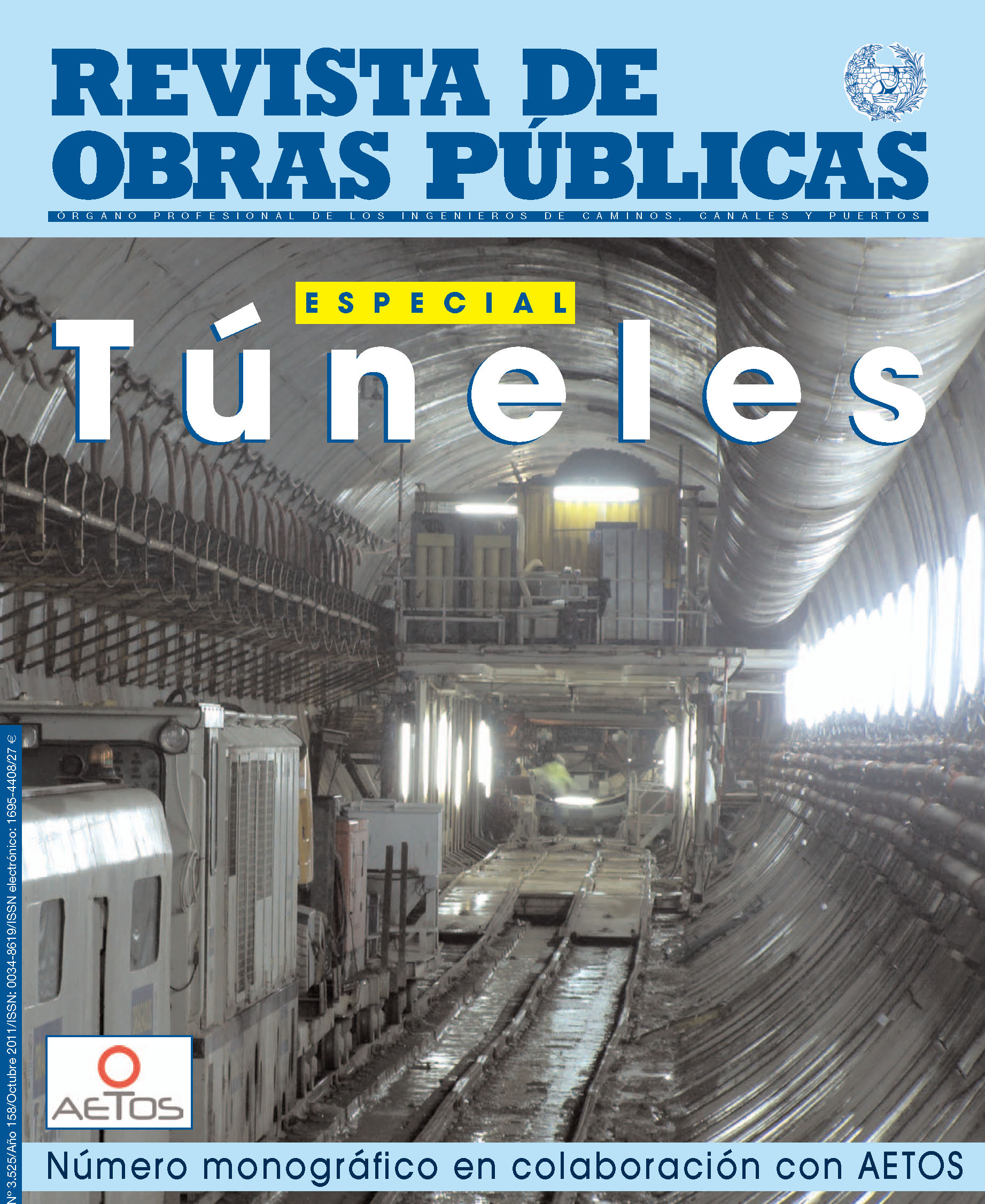
Portada del Número 3525 (Monográfico)

2011 / Número 3525: Especial túneles (Monográfico)
Los túneles de Albertia: problemas de fluencia y anhidritas expansivas
The Albertia tunnels: Problems of squeezing and expansive anhydrite soils
Peña Fernández, Luisa; Rodenas de Miguel, Carmen
Ingeniero de Caminos, Canales y Puertos, Directora de Obra (ADIF). Madrid (España). lpfernandez@adif.es; Ingeniero de Caminos, Canales y Puertos, Directora de Obra (INECO). Madrid (España). carmen.rodenas@ineco.es
Fuente: 2011, 158 (3525): 87-106
Resumen en español
El túnel de Albertia es el túnel más largo de la línea Vitoria – Bilbao, con aproximadamente 4.580 m. A nivel geotécnico, durante la fase de avance se han detectado dos fenómenos que afectan determinantemente a la ejecución del túnel: tramos con presencia de facies sulfatadas (anhidritas y yesos) y tramos afectados por procesos de fluencia. Ambos fenómenos se producen aproximadamente entre el PK 5+700 y el PK 6+300; las coberteras son superiores a 300 m. La presencia de anhidritas provoca fenómenos de hinchamiento de gran importancia al hidratarse y convertirse en yeso. Para afrontar los fenómenos de hinchamiento se ha adoptado una solución rígida. En los tramos donde se han observado fenómenos de fluencia (squeezing), se ejecutaron mallas de bulones autoperforantes y solera provisional en fase de avance. Con el objeto de proceder con mayor seguridad durante la ejecución de la destroza se han ejecutado puntales HEB 300 en fase de avance. Para validar los refuerzos y la sección estructural definitiva en revestimiento, se han realizado modelizaciones mediante programas de diferencias finitas en 3D.
Palabras clave:
Revestimiento en túneles; Anhidritas expansivas; Fenómeno de fluencia; Back analysis
Abstract
The 4580 m long Albertia tunnel is the longest tunnel on the Vitoria-Bilbao railway line. At a geotechnical level, two conditions were detected during the top heading excavation which decisively affected the construction of the tunnel: sections with the presence of sulphated facies (anhydrites and gypsum) and sections affected by squeezing processes. Both these conditions occur approximately between km 5+700 and km 6+600, where the cover is over 300 m. The presence of anhydrites causes serious swelling on hydrating and converting to gypsum. A rigid solution was employed to tackle these swelling problems. In those sections where squeezing was observed, meshes were fixed with self-drilling dowels and a provisional base slab was laid during the top heading excavation stage. In order to ensure greater safety throughout the bench excavation, HEB 300 steel profiles were set during the excavation of the top heading. 3D finite difference models were employed to validate the reinforcement and the final structural section of the lining.
Key words:
Tunnel linings; Expansive anhydrites; Squeezing; Back analysis
Referencias bibliográficas
–[1] MARTÍNEZ-TORRES, L.M. El manto de los mármoles
(Pirineo Occidental): geología estructural y
evolución geodinámica. Tesis Doctoral. Universidad
del País Vasco, 1989. 294 p.
–[2] ESTEBAN MORATILLA, F. “Fenómenos de hinchamiento
de formaciones margo-yesíferas de la
cuenca del Ebro”. Ingeniería Civil, Cedex, 1990, nº
77, p. 87-97.
–[3] ALONSO, E.E.; BERDUGO, I.; ROMERO, E. “Expansive
behaviour of a sulphated clay in a railway
tunnel”. Proceedings of the 16th International
Conference on Soils Mechanics and Geotechnical
Engineering. Rotherdam: Millpress, 2005, vol. 3,
p. 1583-1586. ISBN: 978-90-5966-027-4.
–[4] SULEM, J.; PANET, M.; GUENOT, A. “An analytical
solution for time - dependent displacement in
a circular tunnel”. Int. J. Rock Mech. Min. Sci &
Geomech, 1987, vol. 24, nº 3, p. 155-164.
–[5] PAN, Y.; DONG, J. “Time dependent tunnel
convergence I: formulacion of the model”. Int. J.
Rock Mech. Min. Sci & Geomech, 1991, vol. 28, nº
6, p.469- 475.
–[6] PAN, Y.; DONG, J. “Time dependent tunnel
convergence II: Advance rate and tunnel support
interaction”. Int. J. Rock Mech. Min. Sci &
Geomech., 1991, vol. 28, nº 6, p.477-488.
–[7] SANDOVAL, J.G. Estudio de la convergencia
por fluencia de túneles circulares en medios viscoelásticos
plásticos. Tesis Doctoral. Madrid: ETS
Caminos, Canales y Puertos, 2008, 324 p.
–[8] BARLA, G. Tunnelling under squeezing rock
conditions. Innsbruck: Eurosummer-School in Tunnel
Mechanics, 1995.
–[9] HOEK, E.; MARINOS, P. “Predicting tunnel
squeezing problems in weak heterogeneous rock
masses”. Tunnels & Tunnelling International, 2000,
vol 32, No. 11, p. 45-51 (part 1). No. 12, p. 33-36
(part 2).
–[10] HOEK, E.; CARRANZA-TORRES, C.T.; CORKUM,
B. “Hoek-Brown failure criterion-2002 edition”. Proceedings
of the fifth North American Rock Mechanics
Symposium, Toronto, Canada, 2002, vol. 1,
p. 267–273.
1 artículo publicado en esta revista por: Peña Fernández, Luisa
Los túneles de Albertia: problemas de fluencia y anhidritas expansivas
2011, 158 (3525): 87-106
1 artículo publicado en esta revista por: Rodenas de Miguel, Carmen
Los túneles de Albertia: problemas de fluencia y anhidritas expansivas
2011, 158 (3525): 87-106
Realización del Colegio de Ingenieros de Caminos, Canales y Puertos con la participación del CINDOC.
Con la colaboración del CEDEX-CEHOPU y la Escuela Técnica Superior de Ingenieros de Caminos, Canales y Puertos de Madrid
© Copyright: Colegio de Ingenieros de Caminos, Canales y Puertos (España)
Propiedad del Colegio de Ingenieros de Caminos, Canales y Puertos (España). Prohibida toda reproducción total o parcial sin citar la fuente.
Property of the Colegio de Ingenieros de Caminos, Canales y Puertos (Spanish Society of spanish engineers). Reproduction by whatever means of the whole or any part of the content is strictly forbidden without reference to source



